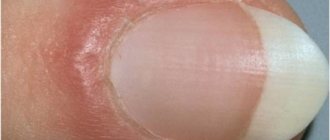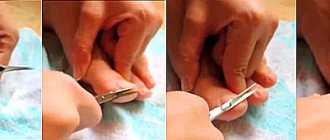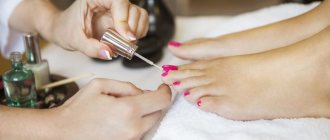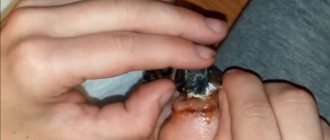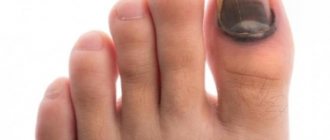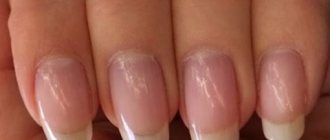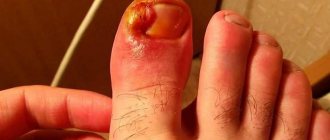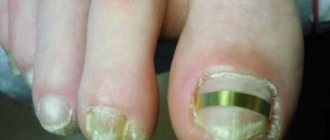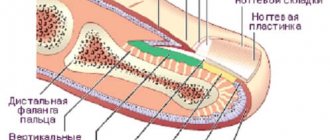Nail diseases
Toenail diseases develop at different ages. Brittle and thick, uneven and curved, colorless and layered nails are all signs of disease. Sometimes diseased nails fall off, after which new ones do not grow for a long time. As you age, these problems can become even more common as circulation deteriorates due to aging.
The most common diseases of toenails:
- dyschromia, which manifests itself as a change in nail color;
- fungal diseases and bacterial infections;
- thickening and rejection of the nail plate;
- delamination;
- nail injury;
- ingrown nails into the skin.
Problems with toenails occur for various reasons. When a person walks, his legs are constantly under tension. Tight shoes often injure your fingers and cause your nails to become deformed. When visiting a bathhouse or swimming pool, the nail may become infected with a fungal infection. Chemicals found in varnishes and soaps can cause nail splitting.
Often the cause of foot diseases lies in the daily stress that accompanies modern man. Bad habits, such as smoking, lead to changes in the color of the nail plate.
Fungal infections
The nail affected by the fungus weakens, may crack or become rough, change color (as in the photo), flake or crumble. Irregularities or growths appear on the surface.
Fungal infections cause fluid to accumulate under the nail plate; a bruise may appear on its surface, and the nail itself becomes deformed and becomes an unnatural color. This happens especially often with the plate of the big toe. The fungus very quickly spreads from damaged areas to healthy areas and neighboring fingers.
Fungal infections can affect the nails due to improper foot care. People who regularly use saunas, swimming pools and other crowded establishments can become infected with the fungus. Factors that increase the risk of developing fungus also include flat feet, poor-quality shoes, increased sweating of the feet, and diaper rash.
At an early stage, foot fungus is treated with external agents with antimycotic properties that act on the pathogen at its location. These products are available in the form of a spray, gel, ointment or varnish and provide the desired effect only for minor manifestations of fungal infections.
Advanced fungal infections that have affected more than half of the nail or several nails cannot be cured with external ointments alone. In this case, their complex treatment is used, which consists of medicinal ointments and tablets.
One of the diseases that most often affects toenails is fungus. Fungal infections can have different pathogens, but are expressed by similar symptoms.
Detachment of the nail on the big toe
Onycholysis is an abnormal change in the keratinized part of the thumbnail, when it is observed to separate from the nail bed. Simply put, a free edge appears at the base, as a result of which the nail structure changes its density and acquires an unusual shade. The recovery process is long and requires an integrated approach to the health problem. Onycholysis can be treated with official and alternative methods, but first it is recommended to eliminate the root cause.
Why do toenails peel off?
If the nail on the big toe peels off in the cuticle area, we are talking about an unpleasant pathology. Externally, these are local foci of necrosis, which darken over time, but first manage to turn yellow. There are several main reasons for peeling of the nail plate; among them, doctors identify physiological and pathological factors. In the first case, the prerequisites for peeling are as follows:
- injury to the big toe;
- a consequence of an allergic reaction of the body;
- wearing uncomfortable and tight shoes;
- use of questionable varnishes and other cosmetics;
- long course of drug therapy;
- poor-quality care of toenails;
- sloppy pedicure.
Pathological factors why the nail on the big toe peeled off may be:
- impaired blood circulation of the lower extremities;
- fungal infection of tissues;
- psoriasis, progressive eczema;
- somatic diseases in the acute stage;
- increased activity of pathogenic infection;
- abnormal growth of the nail plate on the foot;
- chronic diseases of a dermatological nature.
Symptoms
Having found out why the toenails peel off, it is necessary to understand in detail what the main signs of the characteristic ailment are and how to react to them. The answer to the second question is in a timely manner, and as for the unpleasant symptoms of base separation on the big toe, they may be as follows:
- formation of a void under the nail plate;
- visible cosmetic defect;
- first yellowing and then darkening of the pathology focus;
- inflammation of the cuticle with redness of nearby tissues;
- arbitrary separation and removal of the stratum corneum.
Prevention
In order for the nail on the big toe to stop peeling and turning yellow, or to completely prevent this abnormal condition, it is necessary to take preventive measures at home. Doctors give the following valuable recommendations to all patients at risk without exception:
- at the first symptomatology, undergo timely diagnosis;
- perform salt baths as a local antiseptic;
- cut nails on both feet in a timely manner;
- ensure high-quality removal of dirt from under the nail plate;
- adhere to the rules of proper nutrition, enrich the body with vitamins.
Ingrown nail
Another common foot disease is an ingrown toenail. Ingrowth occurs when it is trimmed incorrectly and untimely. When people cut the corners of their nails, they leave sharp ends that can dig into the skin and create small wounds. Infection easily penetrates these areas. After this, redness appears in the area of the ingrown toenail, it swells and hurts (example in the photo). The inflamed area oozes yellowish fluid.
Ingrown toenails most often occur on the big toe. Ingrowth should be treated using several methods:
- Shoes should be comfortable and wide, without heels, and tailored to the size of your feet. Pointed-toe and square shoes contribute to finger rubbing and ingrown toenails. Feet should take a break from shoes as often as possible.
- Foot care should be timely and correct. Be sure to regularly wash your feet in warm water. You should choose simple soap, without harmful dyes that can cause allergies.
- It is necessary to make foot baths with the addition of soothing medicinal herbs.
Sea salt relieves inflammation and redness well. The affected area should be washed with a disinfectant solution of potassium permanganate or furatsilin. The ingrown area should be wiped with hydrogen peroxide. It is imperative to show the problem to a dermatologist. The doctor will prescribe medications to facilitate the healing process or, in severe cases, refer you to a surgeon.
If you do not respond to an ingrown toenail, the wound will fill with pus. If left untreated, over time, the ingrowth can turn into an abscess that will have to be operated on.
Hematoma formation
Nail diseases also develop due to mechanical damage to the fingers. Injury can be caused by a blow from a heavy object, resulting in bleeding and hematoma formation. The nail takes on a blue tint, which indicates burst blood vessels. A slight hematoma, or simply a bruise, quickly resolves on its own. Trauma may also cause white spots on the plate. These spots are a kind of wounds and signal that dystrophy processes are occurring in the body due to lack of calcium.
If the nail is swollen, the area around it is red and very painful, medical attention is needed. You will also need the help of a doctor if, after an injury, the nail begins to peel or purulent discharge is observed from under the nail plate. If the peeling is complete, the nail will need to be removed.
Nail dystrophy, which occurs when it is injured, provokes the development of dyschromia. It radically changes its color, becoming almost black. Dystrophy causes a feeling of rejection of the nail; it begins to gradually atrophy.
Injury to the nail plate and subsequent dystrophy can also manifest itself in excessive flexibility of the nail. Lump-shaped growths often form on the damaged area of the nail plate.
Hematomas can appear on the nail from prolonged use of antibiotics. Such hematomas contribute to the development of more serious diseases - dermatosis, psoriasis and eczema. It is necessary to treat hematoma and associated dystrophy under the guidance of a doctor who will correctly determine the extent of the lesion and the course of treatment.
The appearance of a black area and spots on the nails of the hands and toes: causes
Such a phenomenon as a black spot, which can appear under a transparent nail plate, is a fairly common occurrence. Moreover, almost every person with different hygiene habits and lifestyle can encounter it at least once in their life.
The reasons for this can be various cases: illness, injury. Such a spot can appear on both the fingers and toes. Of course, most often, this is how the fungus manifests itself, but you shouldn’t make hasty conclusions, because it can also appear in completely healthy people who have no complaints.
There are four main reasons that contribute to the appearance of an unpleasant stain on the nail:
- Presence of any fungus (disease)
- Predisposition or increased pigmentation
- Trauma to a finger or nail plate, resulting in a hematoma
- Liver problems and diseases in humans
Each individual case should be considered:
- Hematomas. This is probably the most common cause of stains on the nail. A hematoma is a bruise, simply put. At the site of the impact, blood accumulates, which is located in the soft tissues; it darkens over time and appears under the nail plate itself. This is easy to understand if you know how the nail itself is built. After all, under the plate itself there is quite soft tissue - the nail bed. These two tissues (skin and nail) are very closely related to each other. Upon impact, the capillary network of soft tissue is damaged. The vessels burst and hemorrhage occurs in the tissue. Such a spot does not have clear boundaries and its size depends only on the force of the impact. The blood darkens, acquiring a bluish, purple and black tint. Such a stain can disappear over time. It is often quite painful and produces unpleasant sensations when pressed.
- Increased pigmentation. This is not a common predisposition, but it does occur in some people. The reasons for this tendency to stains can be the consumption of poor quality water and food, direct ultraviolet rays, and even regular human work in harmful conditions. A characteristic feature of this predisposition is the periodic appearance and disappearance of dots. This happens because the blood pigment changes regularly. There is absolutely nothing scary about this, so you shouldn’t scare yourself about it. It is necessary to adjust your diet and lead a healthy lifestyle.
Suspicious black dots on the nails may indicate the presence of oncology in the human body.
Liver problems and diseases. Such darkening of the nail plate can often indicate liver dysfunction. This happens because the organ ceases to cope with its duties, that is, it cannot cope with the processing of toxins. This is why dark and black spots appear on the nail plate in places. As a rule, such spots are usually blurry and do not have clear boundaries and sizes. They may appear and disappear periodically. In this case, you should seek help from a therapist who will prescribe tests for you. In no case should you postpone a visit to the doctor if, in addition to spots, you also notice pain in the liver area
Fungus. The fungus often affects the nail plate of both the hands and feet. In this case, the nail can not only have black spots, but also completely change the color of its plate and become yellow, orange and even brown. Another characteristic sign of fungus is thickening of the nail plate and the appearance of unusual vertical stripes on the nail.
It is important to know that after the nail is damaged, the soft tissues also begin to suffer. In this case, treatment should be started immediately as soon as possible.
Before choosing a medicine, consult a dermatologist if possible. He can order you an important series of tests, the results of which will determine your problems and help you choose effective treatment.
black spots on the nail plate, on the toe
What's wrong with the nail?!
The nail on the big toe hurts and it feels like it is somehow unsteady on the toe; it can be lifted. And if you press, a little liquid comes out. What is this?
Woman.ru experts
Find out the opinion of an expert on your topic
Sheludyakov Sergey
Psychologist, Clinical psychologist. Specialist from the site b17.ru
Ekaterina Gomez Suarez
Psychologist, Psychologist-consultant. Specialist from the site b17.ru
Dyachenko Elena Vladimirovna
Psychologist, Gestalt therapist in training. Specialist from the site b17.ru
Natalya Maratovna Rozhnova
Psychologist. Specialist from the site b17.ru
Sokol Larisa Ivanovna
Psychologist, Gestalt therapist. Specialist from the site b17.ru
Pustovoitova Elena Yurievna
Psychologist. Specialist from the site b17.ru
Muratova Anna Eduardovna
Psychologist, Online consultant. Specialist from the site b17.ru
Slobodyanik Marina Valerievna
Psychologist. Specialist from the site b17.ru
Alexander Trofimov
Psychologist, Online consultant. Specialist from the site b17.ru
Svetlana Chernyshova
Psychologist, Consultant. Specialist from the site b17.ru
Direct route to the surgeon. I wouldn't run something like that. Maybe it's grown in?
There is fungus under the nail. Be prepared for the fact that the nail will fall off, but then a new one will grow, incl. don't die of fear. But you need to go to the doctor for antifungal medications - you MUST take them, otherwise it will be bad.
Probably a fungus! See a doctor! What color is the liquid? Does it smell?
And 14 years ago, the nails on my big toes began to grow in, the corners were festering, and ichor and pus were flowing, I pulled it out from under the nail with a needle. Since then, the nail has been falling off in the corners, there is emptiness there. This is fine? Is there a possibility that it is a fungus? But I think that if there was a fungus, the disease would somehow progress, but it has been the same for 14 years, it has not changed.
Oh, they scared me. I'll go to the doctor, yes. The nail plate is clearly coming off. What is paronychia? 4, The liquid is colorless and odorless. Cherry, what the hell, this can never happen to you? 1, no, it hasn’t grown in at all. I think: I put thick socks into my boots several times, and they really pinched my big toe. Maybe because of this?
Related topics
It’s not a fungus. It’s very serious. You need to see a surgeon to have the nail removed. It’s paronychia. Don’t let it happen under any circumstances.
Well, they scared me! I also had this happen a year ago after a very severe bruise. fluid – could be pus due to an ingrown toenail or infection. treat with alcohol or peroxide. and go to the doctor and check for fungus. Personally, I didn’t have a fungus, it just went away almost completely and became thick due to the bruise. It took six months to grow. I was very afraid that it would fall away. it ached, and if you touched it even a little it hurt. everything is fine now
what is paronychia
Complaint
Moderator, please note that the text contains:
The complaint has been sent to the moderator
The page will close automatically after 5 seconds
Forum: health
New for today
Popular today
The user of the Woman.ru website understands and accepts that he is fully responsible for all materials partially or fully published by him using the Woman.ru service. The user of the Woman.ru website guarantees that the placement of materials submitted by him does not violate the rights of third parties (including, but not limited to copyrights), and does not damage their honor and dignity. The user of the Woman.ru site, by sending materials, is thereby interested in their publication on the site and expresses his consent to their further use by the editors of the Woman.ru site.
Use and reprinting of printed materials from the woman.ru website is possible only with an active link to the resource. The use of photographic materials is permitted only with the written consent of the site administration.
Posting intellectual property objects (photos, videos, literary works, trademarks, etc.) on the woman.ru website is permitted only to persons who have all the necessary rights for such posting.
Copyright (c) 2016-2020 Hirst Shkulev Publishing LLC
Online publication “WOMAN.RU” (Zhenshchina.RU)
Certificate of registration of mass media EL No. FS77-65950, issued by the Federal Service for Supervision of Communications, Information Technologies and Mass Communications (Roskomnadzor) on June 10, 2016. 16+
Founder: Limited Liability Company "Hirst Shkulev Publishing"
What's wrong with the nail?!
The nail on the big toe hurts and it feels like it is somehow unsteady on the toe; it can be lifted. And if you press, a little liquid comes out. What is this?
Woman.ru experts
Find out the opinion of an expert on your topic
Sheludyakov Sergey
Psychologist, Clinical psychologist. Specialist from the site b17.ru
Ekaterina Gomez Suarez
Psychologist, Psychologist-consultant. Specialist from the site b17.ru
Dyachenko Elena Vladimirovna
Psychologist, Gestalt therapist in training. Specialist from the site b17.ru
Natalya Maratovna Rozhnova
Psychologist. Specialist from the site b17.ru
Sokol Larisa Ivanovna
Psychologist, Gestalt therapist. Specialist from the site b17.ru
Pustovoitova Elena Yurievna
Psychologist. Specialist from the site b17.ru
Muratova Anna Eduardovna
Psychologist, Online consultant. Specialist from the site b17.ru
Slobodyanik Marina Valerievna
Psychologist. Specialist from the site b17.ru
Alexander Trofimov
Psychologist, Online consultant. Specialist from the site b17.ru
Svetlana Chernyshova
Psychologist, Consultant. Specialist from the site b17.ru
Direct route to the surgeon. I wouldn't run something like that. Maybe it's grown in?
There is fungus under the nail. Be prepared for the fact that the nail will fall off, but then a new one will grow, incl. don't die of fear. But you need to go to the doctor for antifungal medications - you MUST take them, otherwise it will be bad.
Causes of pathology
The appearance of pus under the nail is a consequence of the work of the protective system. Essentially it is a mixture of living and dead white blood cells. Such blood cells accumulate in areas where the inflammatory process occurs. The immune system ensures the destruction of pathogens that have penetrated under the nail plate and into the soft tissues.
Inflammation on the toes develops quickly. This is due to the difficulty of maintaining absolute purity. High humidity is a favorable environment for the development and activity of pathogenic microorganisms.
Treatment of pathology is associated with stopping the inflammatory process. It is also important to draw out any existing pus from under the nail. If you suspect the presence of panaritium, you should consult a doctor. It is not possible to remove pus yourself in all cases.
Treatment of pus under the fingernail or toenail
| In contact with: |
| Facebook: |
| Classmates: |
There is such an unpleasant and dangerous disease of the periungual area as felon, accompanied by the formation of an abscess under the nail. This is a rather painful formation that interferes with full life activity. The inconvenience is also caused by the fact that the external picture of the manifestation of the disease looks very unattractive and causes concern on the part of others.
This problem requires close attention and timely assistance. “The Perfect Manicure” will tell you what to do if pus has formed under the nail. Looking ahead, we will say that the measures presented below are in the nature of first aid and are effective only in the initial stages of the formation of felon. Serious complications require medical intervention and adequate treatment.
Suppuration of the nail. Characteristics of the problem
First, let's figure out what panaritium is. This is an inflammation of the soft tissues, mainly of the periungual area - the cuticle or lateral ridges - caused by the action of pathogenic bacteria of the streptococcus or staphylococcus group. Sometimes the localization of inflammation spreads deeper and extends under the entire nail, involving bone tissue and even tendons.
The following types of panaritium are distinguished:
Depending on the location of the problem:
- An abscess under the fingernail.
- Suppuration under the toenail (more common).
Depending on the affected area:
- Focal when one finger is affected.
- Extensive, when suppuration is observed on several fingers.
- In severe cases, with the simultaneous formation of an abscess under the nail on the toe and fingers, and on all fingers, one should speak of general sepsis of the body and a weakening of its protective functions.
There are two types of disease progression:
- Acute panaritium, when there is a rapid development of the disease with pronounced pain, redness and swelling, extensive localization of the abscess and partial immobilization of the injured limb. If you have these symptoms, you should immediately consult a doctor.
- Chronic (or increasing) panaritium. With this variant of the course of the disease, discomfort is felt in the affected area, pain occurs when pressing on the source of inflammation. There is slight swelling and redness of the skin. This course of the pathology is more favorable and the problem can be corrected independently using conservative and traditional methods. But it is important to start treatment on time, otherwise if the problem is started, it may progress to a stage where pus forms under the fingernail or toenail.
If you are faced with the latest variation of felon, carefully monitor the inflammation and do not let the problem take its course, otherwise complications such as:
- Sepsis. Severe blood poisoning, if not properly treated, can lead to death.
- Phlegmon. It is characterized by the spread of suppuration deep into the adipose tissue.
- Tenosynovitis. It affects the tendon area, resulting in necrosis, leading to complete immobilization of the fingers.
Onycholysis: what to do if the nail peels off?
Onycholysis is a type of onychodystrophy (pathological change in shape, structure or color), in which the nail separates from the nail bed on the toes or fingers.
This defect occurs predominantly in adults, regardless of age. Moreover, in women, more often than in men.
The disease spoils the appearance of nails, makes them brittle, brittle, and provokes bacterial and fungal infections.
In 60% of cases, onycholysis develops after a blow, from injury, or when a nail is pinched. Moreover, even a minor injury is enough that a person will not pay attention to. The second most common cause of nail onycholysis is fungal infection (onychomycosis). The disease is also caused by allergies. For example, when hands come into contact with household chemicals.
Depending on the cause, the nail may be affected only on one finger or on several fingers at the same time.
The risk group includes people who have:
- chronic skin diseases (eczema, psoriasis);
- malnutrition, deficiency of vitamins A, E, group B;
- metabolic disorders;
- predisposition to allergic reactions;
- weakened immunity, including during pregnancy and old age;
- diabetes.
The disease onycholysis often appears in workers in the chemical industry and laboratories, whose hands are constantly in contact with organic solvents and aggressive substances.
Due to the desire for beauty, women face this problem more often than men.
Onycholysis is caused by:
- nail extensions;
- improper performance of manicure or pedicure;
- injury to the cuticle area;
- the use of decorative varnishes, liquids for their removal containing harmful organic solvents;
- gel polish coating.
Almost all women like to do the procedures listed above to make their hands look attractive and well-groomed. But the first thing to remember is safety. Because many of them do not have the most favorable effect on nails. Cause allergic reactions, chemical burns, burns from an ultraviolet lamp.
Often onycholysis occurs on the hands from gel polish or shellac. Why is this happening? The reason is ignoring precautions. When drying under a UV lamp, the nail burns. Therefore, if the master says, take it out, if he bakes, you need to do it.
If you tolerate the burning sensation for a couple of minutes, the consequences can be dire. You risk being left not only without a manicure, but also without nails. The burning sensation provokes a burn, a disruption of the connection between the plate and the nail bed.
Therefore, you need to take your hands out from under the lamp for a few seconds until the discomfort disappears.
In addition to the above reasons, the disease is caused by long-term use of medications that increase the body's sensitivity to solar radiation. We are talking about antibiotics from the group of penicillin and tetracycline. For example, in the instructions for the drug Doxycycline, the list of adverse reactions states that it can cause photoonycholysis, a change in the color of nails.
The causes of onycholysis on the arms and legs are different. Toenails are less likely to undergo aesthetic manicure procedures, but are more often injured. Most often, detachment of the nail plate occurs on the big toe due to mechanical compression from tight closed shoes, flat feet, improper distribution of the load on the foot, disruption of its biomechanics, and long nail length.
Kinds
Depending on the cause, there are several types of disease.
The most common onycholysis is:
- Traumatic. Nails begin to peel off after blows, wounds, burns, splinters, exposure to heat, cold, prolonged exposure to water, or wearing tight shoes. This also includes pathological changes caused by the action of acids, alkalis, solvents, and household chemicals;
- Fungal. It occurs due to the entry and reproduction of fungal infection pathogens in the subungual space. Formed as a secondary complication of onychomycosis;
- Allergic. Onycholysis develops as an allergic reaction due to taking medications with photosensitizing properties, ultraviolet irradiation (photo onycholysis), and contact of the nail plate with harmful chemicals.
Depending on the size of the affected area, onycholysis can be partial, when only a small area of the nail peels off in the form of a strip or semicircle, and complete, when it comes off entirely. Separation of the nail plate can occur from the distal (free) edge or from the lateral ridges (lateral onycholysis).
How to recognize the disease?
With onycholysis, voids form under the fingernail, caused by its inability to grow to the nail bed and air entering the resulting cavity. The main symptom is a change in the color of the nail plate. It becomes cloudy, whitish-gray. In this case, the detachment border most often has uneven edges. Similar symptoms are observed on the legs.
With an infectious cause of the disease, the nail additionally changes its structure, its surface becomes rough, and the color is yellow, brown or green.
With onycholysis, the nail does not grow and becomes brittle and brittle. If an infection gets into the subungual space, a person feels discomfort, pain, and suppuration.
Diagnostics
If you suspect detachment of the nail plate, you should visit a specialist (podiatrist, dermatologist). To confirm the diagnosis and find out the cause of onycholysis, a fungal test is performed.
Based on external signs, it can be confused with onychomycosis, psoriasis, lichen planus and other types of onychodystrophy. Therefore, differential diagnosis is needed. A fungal infection is indicated by a yellow, brown or green color of the nail, its thickening, an unpleasant odor, and itching of the skin around it.
Many who have encountered onycholysis are interested in whether it is contagious? It is not contagious in itself. But often its cause is a fungal infection, which is easily transmitted from one person to another through contact and household contact.
Treatment
Treatment of the disease is long-term, taking up to 5–6 months. Selected individually, taking into account the reason. For help, you need to contact a dermatologist, podologist, or mycologist. The larger the area peeled off, the longer the recovery will be.
Treatment for nail onycholysis includes:
- cleaning or removing the exfoliated part of the nail plate;
- fight against fungal infection, if it has been detected;
- protection of the exposed soft tissue area;
- prevention of infectious complications;
- stimulation of nail growth;
- correction of a cosmetic defect.
It is recommended to consult a doctor immediately. The use of folk remedies and methods to treat onycholysis without consultation is fraught with complications. It is very important not to let the problem take its course. The more time is lost, the less likely the nail will grow. When a cavity forms between the nail and the nail bed, the skin becomes hard over time and can no longer adhere to the nail.
The main thing that needs to be done to effectively treat nail onycholysis is to stop the influence of the traumatic factor. If the detachment occurs due to an allergy to washing powder or cleaning agent, you need to change them to others and use thick rubber gloves.
If the cause is infection, measures are necessary to destroy the pathogen. To combat the fungus, varnishes, local ointments, and creams are used. In severe cases, antifungal drugs are added orally. The course of treatment and specific medications are prescribed by the doctor. For bacterial infections, antibiotic ointments are prescribed.
If detachment of the nail plate occurs due to a nail injury, prosthetics with a special medical gel are used to correct the cosmetic defect. It differs from standard gels that are used for extensions.
Made from hypoallergenic components, does not cause an allergic reaction or burn. Gel prosthetics for onycholysis helps to close soft tissues, minimize the risk of injury to the nail bed, and prevent infection.
Materials for prosthetics contain antifungal and antiseptic additives. But this method can only be used in the absence of infection.
To speed up nail growth, vitamins, iron and calcium supplements are prescribed. Local remedies (oils, cuticle creams) and finger massage are also used to improve blood circulation.
Care during treatment
Until a new nail grows after stripping and its connection with the nail bed is restored, gentle care will be required.
It is forbidden:
- apply any irritating substances to the nail of the affected finger;
- paint your nails with varnish or try to disguise the defect with gel polish;
- wash dishes, use household detergents without gloves;
- use sharp instruments when performing a pedicure or manicure.
Take care of the health of your nails! Visit a podiatrist periodically to detect violations in a timely manner. To treat onycholysis in Moscow, ingrown toenails, fight against onychomycosis, calluses and other problems, contact the Eva Korneeva Podology Center for professional help from specialists with more than 10 years of experience.
Make an appointment by phone.
Source: https://g2f.ru/stati/onixolizis-chto-delat,-esli-otslaivaetsya-nogot
Why did pus form under the nail and what to do?
The reasons leading to such a terrible illness are commonplace, and anyone can encounter them:
- Inadequate hand and foot hygiene. Due to constant contact with the environment, hands contain a large number of bacteria that are difficult to wash off even when using an antiseptic. Feet, due to prolonged and frequent stay in closed shoes, are simply an ideal environment for the development of pathogenic microflora. This is why pus often forms under the nail on the big toe.
- Microtraumas and damage to the nail and periungual area. Even a banal splinter that has entered under the nail can lead to the formation of an abscess under the fingernail, the treatment of which will take a long time.
- Bad habits - thumb sucking, nail biting. It would seem that these are banal childhood habits, but they can also lead to serious consequences.
- Poorly done manicure and pedicure. Cuts, trauma to the nail plate, neglect of hygiene and asepsis - all this can lead to the development of panaritium.
First aid for a nail injury
, place your hand or foot under running cold water as quickly as possible . This is necessary to prevent the appearance of a hematoma under the nail , which provokes detachment of the nail plate. The injured limb should be kept in the cold for at least 15 minutes to constrict the blood vessels and eliminate pain.
To avoid swelling, an iodine mesh is applied to the skin and a tightening bandage is applied. This will minimize the risk of the nail moving away from the nail bed.
puncture to release blood from a hematoma
If a hematoma has formed, you should consult a doctor for a minor surgical intervention: a small hole is made in the nail so that the blood that has accumulated under it can come out.
If it is impossible to visit a specialist, you can try to carry out these manipulations at home under the condition of complete sterility . To do this, you need to thoroughly wash your hands and treat the bruise with an antiseptic solution, take a sterile needle, and heat it over a fire. After making a hole in the nail plate, remove the blood from under it. Then re-treat the nail.
If detachment of the nail plate occurs due to injury, you must immediately take the following steps:
- First you need to disinfect your tweezers or nail scissors. Use them to cut off the peeling part (if it is at the tip of the nail).
- Treat the nail plate and the tissue around it with an antiseptic solution (iodine, chlorhexidine).
- Add 2 tablespoons of sea salt and 5 drops of tea tree oil to 250 ml of water, pour the solution into a basin, and lower the injured limb there. Do the bath for 20 minutes , then blot dry with a towel.
- Apply a cream with soothing and regenerating properties ( “Bepanten”) . Repeat these procedures for several days.
- To prevent bacteria and fungi from growing under the peeling nail plate, you should maintain daily hygiene of your hands and feet .
The video discusses in detail nail puncture for bruises.
How to treat an abscess under the fingernail and toenail
What should you do if pus does form under your toenail or fingernail? First you need to conduct an independent visual examination. If you see redness, extensive swelling and discoloration of the tissue, and palpation of the affected area responds with severe throbbing pain, you should immediately seek help from a doctor. In this situation, it is unsafe to self-medicate; suppuration can quickly penetrate deeper and cause irreparable harm.
The doctor will prescribe treatment, which will depend on the degree of development of the problem. Thus, conservative treatment methods involve taking a course of antibacterial drugs and external hygiene procedures.
Advanced and acute cases require immediate opening of the abscess. But how to remove pus from under the nail if its source of inflammation is located directly under it? In such particularly severe cases, surgery is required to remove the nail plate and further treatment of the wound under the supervision of a doctor. The healing period is 5 - 7 days, but in the future it is necessary to regularly perform antibacterial procedures - applying aseptic dressings and using medicinal baths.
If the abscess is small or has not yet developed, or for some reason you cannot urgently consult a doctor, then traditional remedies will come to your aid. So you can carry out the following activities yourself at home:
- Disinfecting baths and baths that help draw out pus from under the nail.
- Therapeutic compresses.
- Applications based on antibacterial ointments.
Before taking baths or other methods of treating an abscess, you should carefully treat the affected area with an antiseptic - iodine, hydrogen peroxide, alcohol. This way you will partially reduce the number of bacteria.
Let's look at each method in more detail.
How to remove pus from under a nail using medicinal baths
Based on their effect on the problem, baths can be divided into two groups:
- Antiseptic, aimed at disinfecting wounds.
- Pulling out suppuration.
The first group includes baths with infusions of chamomile, string, calendula and disinfectants - hydrogen peroxide, iodine solution, furacelin, potassium permanganate, etc. All of them should be prepared using warm water; hot water is contraindicated due to the risk of increasing the area of suppuration, since elevated temperature is an ideal environment for the further development of pathogenic bacteria.
The second group includes salt baths. Moreover, they should be very salty (concentration of 5 tablespoons of table salt per liter of water). To soften the water, you can add soda to the salt solution (1 teaspoon per liter of water). In this case, the bath should be as hot as your legs or arms can tolerate. The thing is that hot water wrinkles the skin and, under its pressure, pus begins to flow out of the wound, while salt water will draw all the moisture into itself, including purulent fluid.
Know that if an abscess has formed under a fingernail or toenail, you cannot open the abscess on your own! If it has not opened on its own, then it can only be opened in a hospital setting.
Baths should last 20 minutes at least three times a day.
Compresses
Ordinary raw beets, grated garlic, propolis, boiled onion puree, pulp of aloe leaves and even crushed plantain leaves are effective means of drawing out pus from under the nail. Any of these remedies, in the form of a compress, should be applied to the wound surface and tightly tied with gauze.
All compresses should be done at night, so you will not disturb the wound and ensure long-term exposure of beneficial substances to the affected area.
Therapeutic applications
To perform therapeutic applications, you will need any antibacterial ointment - Levomekol, Tetracycline, etc. An excellent remedy for pus under the nail is Vishnevsky ointment, it helps to draw out pus from the wound. Therapeutic applications are made as follows: gauze folded several times is soaked in a medicinal preparation and then applied to the wound surface. For fixation, you can use a fabric-based patch or a regular bandage.
Applications, like compresses, should be performed at night.
Ideally, a comprehensive approach to solving the problem is required: the use of medicinal baths and the application of compresses or applications.
In conclusion, we note once again that felon is a serious disease that requires medical supervision and self-treatment is permissible only in mild cases in the initial stages, when conventional antiseptic procedures are still effective, or as supportive measures to relieve acute pain. Well, most importantly, carefully monitor your health and avoid situations that provoke the occurrence of panaritium.
Bruised toenail leaking fluid
Many patients who come to see a dermatologist complain about fluid accumulating under the nail. Moreover, the liquid can be either yellow or pinkish, transparent or greenish.
Unfortunately, most people come to the doctor with an already advanced problem that will not be easy to solve.
There are several reasons for the appearance of such a defect, and all of them are associated with fungal and infectious infections, as well as injuries.
The main reasons for the problem
In approximately 45% of all clinical cases, the cause of fluid accumulation under the nail is a fungal infection or onychomycosis.
You can “pick up” such a fungus in any public place where there is increased air temperature and humidity.
You can become infected with a fungal infection even on a sea or river beach (however, this is rare). Mostly, patients suffering from this pathology become infected in public swimming pools, saunas and showers in fitness clubs.
With this disease, not only is there an accumulation of greenish-yellow liquid under the thickness of the nail, the patient is also worried about a change in the color of the nail plate from yellow to green-black, its peeling and destruction . In especially advanced cases, the nail begins to crumble and then completely move away from the bed.
But not only fungus can cause the appearance of fluid and voids under the nail. The nail plate can also be affected by strong impacts and other mechanical damage. In this case, pink or red liquid (blood) will accumulate under the nail plate, and a severe hematoma will form around and underneath it.
Separation of the nail and accumulation of fluid under it can also occur for other, non-infectious reasons:
- exposure to chemicals (including aggressive laundry detergents, personal care products, creams or varnishes);
- allergic reaction to acrylic or gel nail extensions;
- long exposure of hands and feet to a humid environment or water (the problem is especially often faced by nurses, cleaners, workers at car washes or water parks, etc.);
- mechanical damage to the nail plate when cutting its edge incorrectly or carelessly with nail clippers or scissors (this leads to the formation of many small cracks, due to which the nail may begin to come off and open the way for harmful bacteria that cause suppuration);
- allergic reaction to other third-party substances (including food);
- hypovitaminosis (lack of vitamin E, A or B, as well as lack of iron, calcium or magnesium);
- hormonal disorders;
- long-term use of antibiotics;
- failure of blood circulation and metabolic processes (including dropsy).
In some cases, the following pathologies affect the peeling of nails and the accumulation of fluid under them:
- psoriasis;
- atopic dermatitis;
- eczema;
- dermatosis (bullous).
Pus under the nail on the big toe
Big toes are prone to injury. Often people encounter cuts, abrasions, bruises, and splinters. Children are most vulnerable because their skin is more delicate than that of adults. If the affected area is not treated with antiseptic agents in time, inflammation may begin.
The skin turns red and pus appears under the nail on the big toe. In medicine, this condition is called panaritium. It is characterized by inflammation of the soft tissues of the finger, redness and swelling, severe pain, the appearance of pus, and the inability to move the phalanges of the finger.
Perhaps an increase in temperature and the appearance of severe throbbing pain.
The disease develops when bacteria or other infections enter the microtrauma. Panaritium is caused by streptococci, staphylococci or fungi. A mixed type of disease is possible.
Main symptoms
Pathology has its own characteristic symptoms. Based on these characteristics, it is differentiated from other conditions.
- A person is bothered by painful sensations. Their intensity is high. The nature of the pain is pulsating. It appears not only when walking, but also in a calm state.
- If the finger festers, the soft tissues swell. The swelling is quite severe. The periungual fold becomes rigid. Sometimes the entire foot swells.
- Redness also indicates suppuration. A change in skin color is observed directly around the damaged nail.
- A local increase in temperature indicates that there is pus under the nail. The finger becomes hot.
Subungual felon may not show other visual signs. As it develops, large amounts of pus accumulate. The nail gradually changes. The plate may thicken or crumble. Pathogenic microorganisms destroy the nail bed.
If there is a lot of pus, then the symptoms intensify. The pain becomes unbearable. An accumulation of leukocytes is noticeable in the corner of the damaged nail. It is visualized as a yellowish spot under the top layer of skin. In severe cases, when the inflammatory process spreads throughout all soft tissues, a person experiences an increase in body temperature. This is a reason to contact a specialist.
